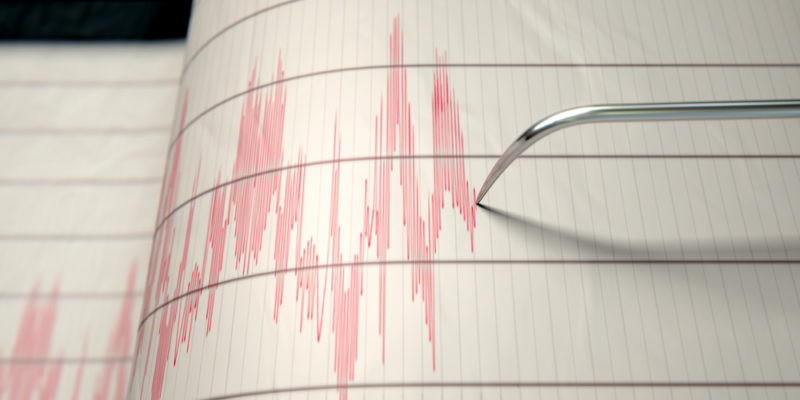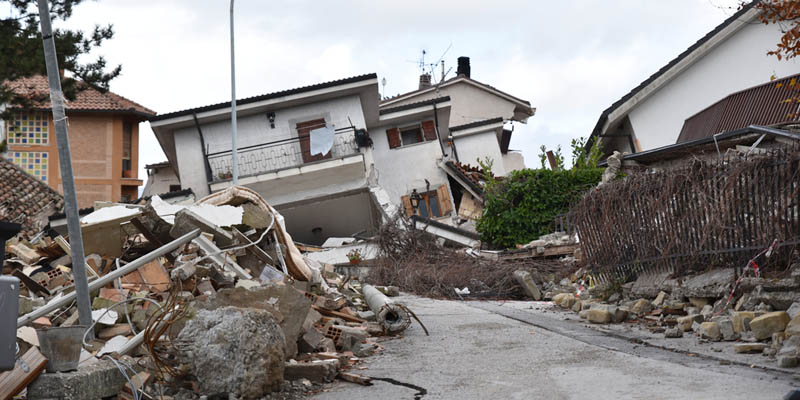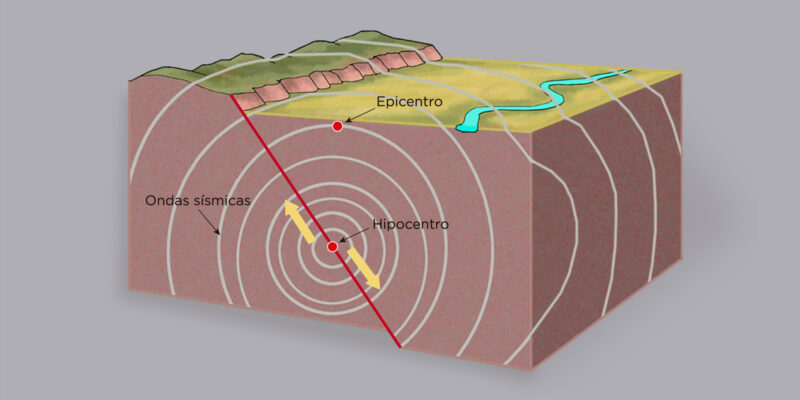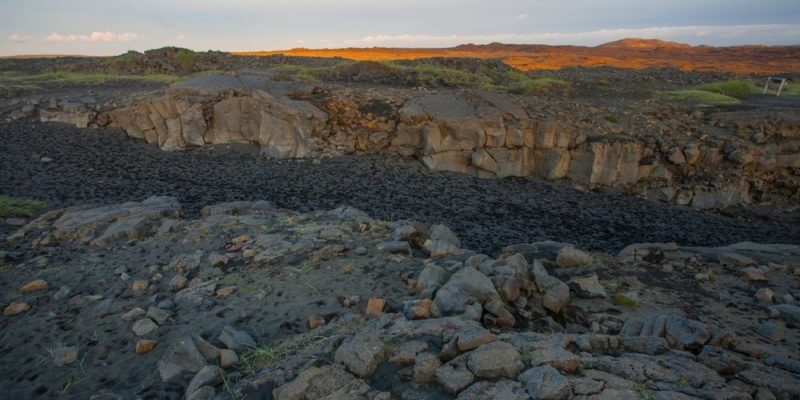We explore earthquakes, and explain their causes and effects. In addition, we discuss what to do in the event of an earthquake, and detail the largest earthquakes ever recorded.

What is an earthquake?
An earthquake is the vibration of the Earth caused by a rapid release of energy. Most commonly, earthquakes occur due to the displacement of the tectonic plates that make up the Earth's surface.
Tectonic plates are large blocks of the Earth's crust that are in slow but constant motion. The energy from the thrust and friction forces between them accumulates and is sometimes released suddenly. This release of energy, which occurs in the interior of the planet, sometimes reaches the surface causing sudden vibrations known as earthquakes.
Earthquakes can range from mild to intense: they may go unnoticed (hundreds of seismic events occur daily without being felt on the surface), or may have devastating effects.
How is earthquake magnitude measured? The magnitude of an earthquake is measured on the Richter scale. Magnitude refers to the amount of energy released by the earthquake, and is measured from 0 to 10. A 0 magnitude earthquake on the Richter scale is imperceptible on the surface, while one of 10 represents the highest magnitude, releasing an amount of energy equivalent to the total annual energy consumption of the United States.
- See also: Tornado
What is seismology?

Seismology is the branch of geophysics concerned with the seismic waves that produce earthquakes. The study and understanding of seismic waves allows for the research of the causes, distribution, and effects of earthquakes. Although they still cannot be predicted far in advance, seismology has made progress in the estimation of earthquake occurrence in certain regions.
To study seismic waves, an instrument called a "seismograph" is used. A seismograph or seismometer is an instrument invented in 1842 and improved over time, designed to detect seismic waves originating in the Earth's subsurface.
Since there are two types of waves, P (horizontal) and S (vertical), two types of seismographs are required. In the case of P waves, a seismograph consisting of a suspended pendulum is used, which moves sideways upon detecting the arrival of horizontal waves.
For S waves, a seismograph supported by a hinge is used, which moves up and down when it detects the arrival of vertical waves.
The records obtained by seismographs, called seismograms, provide a great deal of information about the behavior of seismic waves and earthquakes.
Causes of an earthquake
Most earthquakes originate as a consequence of the movement of tectonic plates. Plates interact with each other at their boundaries, where energy accumulates due to the push or friction between them.
In addition, other phenomena may cause earthquakes, including:
- Volcanic eruptions. Earthquakes may occur in the crust when eruptions are explosive and release large amounts of energy.
- Explosions. Mining activity and oil extraction by hydraulic fracturing often involve breaking rock to reach the desired resource. For this purpose, detonations with explosives are used, which may generate strong vibrations on the surface even in areas far away from the explosion site.
- Weapons testing. Explosions from bomb or missile detonations may generate surface vibrations, causing small earthquakes.
- Meteorites. The impact of a meteorite on Earth may generate seismic waves and vibrations on the surface.
How long does an earthquake last?
Earthquakes typically last a few seconds. However, they can be very destructive. The longer-lasting earthquakes can reach up to 120 seconds. The duration of an earthquake depends on the amount of energy released and the location where the earthquake occurs.
Smaller earthquakes often precede the main earthquake. Less intense vibrations might be felt on the surface a few hours or days before the main earthquake occurs. These movements are known as "foreshocks".
Other seismic movements may also occur after an earthquake. These smaller seismic movements are called "aftershocks", and although much weaker than the main earthquake, they can cause significant damage by affecting a previously weakened area.
Effects of earthquakes

Damage caused by earthquakes is measured using the Mercalli intensity scale. The damage on the surface depends not only on the magnitude of the earthquake but also on the materials and designs of buildings. A low-magnitude earthquake affecting unprepared structures can cause significant damage. Conversely, a higher-magnitude earthquake over an area with earthquake-resistant constructions might have a lower Mercalli intensity scale rating.
The Mercalli intensity scale is measured in values from 1 to 12. Intensity 1 means the earthquake is practically imperceptible on the surface and causes no damage. Intensity 12, the highest on the scale, means that damage is total. Intensity 6, the intermediate level, means the earthquake is widespread, heavy objects like furniture, trees, and even walls move, with some structures being damaged.
Main features of an earthquake

The main features of an earthquake are:
- Hypocenter or focus. It is the location below the Earth's surface where the release of energy occurs.
- Epicenter. It is the location on the surface situated directly above the focus or hypocenter. Being the closest location to the point of energy release, it is where vibrations are felt most strongly and where most damage occurs.
- Seismic waves. These are the waves through which the energy is transmitted from the source to the surface. There are two types:
- P waves or primary waves move horizontally, are the first to be felt, and are responsible for shaking objects from side to side on the surface.
- S waves or secondary waves take longer to be felt as they are slower, move vertically, and cause objects on the surface to "jump" up and down.
What are the world’s major earthquake zones?

Generally, the areas with the world’s highest seismic occurrence are those where tectonic plates exert pressure on each other. These zones are called "faults". Faults are mainly located along the edges of tectonic plates.
Among the most active seismic zones in the world are:
- Pacific Ring of Fire. It extends along the Pacific Ocean coastline through North America, South America, and Asia. It is located on the edges of the Pacific, Nazca, Philippine, and Antarctic tectonic plates. It is known as the “Ring of Fire” for being an area with a great number of active volcanoes which erupt periodically.
- Mediterranean region. It extends along countries by the Mediterranean Sea, especially at its eastern end, where the edges of the African, Eurasian, Arabian and Anatolian plates converge.
- Central Asia. It extends near the Himalayas. It is a seismic zone due to the interaction of the boundaries of the Indian and Eurasian plates.
Real-time earthquake watch. Monitors worldwide keep local as well as international records of seismic activity. The institutions watching earthquakes disseminate information in real time, providing data on their location and magnitude. Many of them provide real-time maps displaying earthquakes immediately after they are recorded.
Largest earthquakes in history
The highest-magnitude earthquakes in recorded history are:
| Earthquake | Location | Year | Magnitude on the Richter scale |
|---|---|---|---|
| Valdivia Earthquake | Chile | 1960 | 9.5 |
| Indian Ocean Earthquake | Indonesia | 2004 | 9.3 |
| Alaska Earthquake | United States | 1964 | 9.2 |
| Japan Earthquake | Japan | 2011 | 9.1 |
| Kamchatka Earthquake | Russia | 1952 | 9.0 |
| Chile Earthquake | Chile | 2010 | 8.8 |
| Sumatra Earthquake | Indonesia | 2005 | 8.6 |
| Assam Earthquake | India | 1950 | 8.6 |
Other high-magnitude earthquakes are believed to have occurred throughout history, such as those in Lisbon in 1755, Lima in 1746, and Arica in 1868. However, it is not possible to determine their magnitude, since no instruments existed at the time to measure the energy released, nor was the Richter scale still in use.
What to do during an earthquake
Governments usually establish a set of recommendations for the population to take shelter and stay safe in the event of an earthquake. Some of these recommendations are:
- Stay calm. Avoid panicking, running, or pushing others.
- Find a safe place. Try to stay inside a building, away from windows and objects that may fall such as lamps, mirrors, shelves, and paintings.
- Duck and take cover. Cover your head with your arms and get under a heavy table or desk in case the ceiling collapses.
- Do not use elevators or stairs. Elevators may stop or suffer damage, while stairs may collapse.
- Do not light matches or turn on electrical devices. The earthquake might have caused pipes to break, leading to a gas leak, and thus increasing the risk of explosion.
- Follow evacuation instructions. Once the shaking has ended, go outside the building in an orderly manner and head to the designated meeting and evacuation points.
References
- Ecoexploratorio (s.f). ¿Qué son los terremotos? Ecoexploratorio
- NASA Ciencia Space Place (s-f). ¿Qué es un terremoto? Spaceplace
- Tarbuck, E. y Lutgens, F (1999). Ciencias de la Tierra. Una introducción a la geología física. Prentice Hall.
Explore next:
Was this information useful to you?
Yes NoThank you for visiting us :)